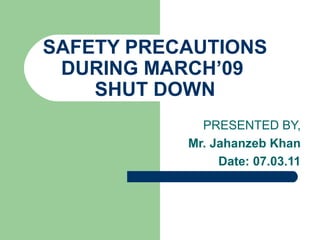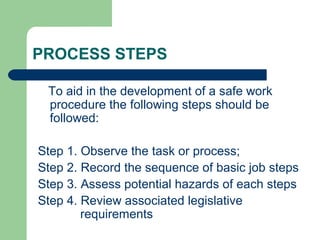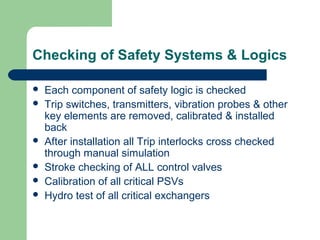Safe work procedure1
- 1. SAFETY PRECAUTIONS DURING MARCHâ09 SHUT DOWN PRESENTED BY, Mr. Jahanzeb Khan Date: 07.03.11
- 2. KRIBHCO SHYAM FERTILISER LTD. AMMONIA PLANT ïŽ COMMISSIONED ON 22/11/1995 ïŽ REASSESSED CAPACITY 1520 MTPD (w.e.f. 01/04/2000) ïŽ TECHNOLOGY HALDOR TOPSOE UREA PLANT ïŽ COMMISSIONED ON 23/11/1995 ïŽ REASSESSED CAPACITY 2 X 1310 MTPD (w.e.f. 01/04/2000) ïŽ TECHNOLOGY SNAM PROGETTI
- 3. ATR- March 2009 ïŽ Duration- 19.5 Days ïŽ Dates -Start of shut down : 13/03/2009 -Urea one unit production : 31/03/2009 -Ammonia production : 01/04/2009 -Urea 2nd unit start up: 01/04/2009
- 4. Ammonia Plant -Primary reformer tube & catalyst replacement. -Secondary reformer job -RG Boiler job -HTS Catalyst job -Synthesis gas turbine overhauling -Ammonia converter jobs -Synthesis loop boiler Replacement MAJOR JOBS
- 5. Energy saving Schemes ïŽ Ammonia Product Heater installation ïŽ PR NG Fuel pre heating ïŽ PAC discharge line modification ïŽ CAPH duct modification ïŽ Ammonia Plant DCS replacement
- 6. Urea Plant ïŽ Urea reactors and stripper inspection ïŽ Exchangers cleaning ïŽ Blow down and vent stack pipe replacement ïŽ HP passivation air compressor installation ïŽ Prilling Tower epoxy coating ïŽ Bentley Nevada vibration monitoring system hook up
- 7. Offsites ïŽ CT return header shifting Job ïŽ GTG-I Generator overhauling
- 8. Why Annual Turnarounds ???? ïŽ ATR, a planned activity- annually or biannually ïŽ Annual turnarounds for: -Jobs â Breakdowns, repairs, overhauls, improvements, modifications etc -Statutory compliances -Cleaning of equipment -Catalyst loading, washings, internal repairs -Inspections and testing of equipment & machines -Adding new equipments -Up gradations & replacements
- 9. Shutdown job lists ïŽ ATR job list include -Uncompleted jobs from the previous ATR -Jobs identified during the entire year -Special inspections â statutory, testing, improvements -Jobs out of analysis reports â NDT, tech suppliers, OEMs -Jobs that can be only done during utilities stoppage -Jobs on vessels for catalyst change, cleaning, repairs etc
- 10. Jobs Planning ïŽ Job lists reviewed on monthly basis between departments ïŽ Unique job number for each job which gets frozen ïŽ All jobs are identified & tagged in field before ATR ïŽ Each job planned â manpower, material & timelines ïŽ Bar chart for major planned jobs ïŽ Spacing of jobs as per vendor availability ïŽ Risk assessment for each job by process & maintenance ïŽ No job done without a permit
- 11. Material / Spares planning ïŽ Done well in advance â ATR material separately identified ïŽ Early orders for each critical items & OEM supplies ïŽ All temporary lines, fittings, structures - pre fabricated ïŽ Prior testing & overhauling of equipments like ïŽ Cranes, forklifts, lifting tools etc ïŽ Access equipment, hydraulic platforms etc ïŽ Portable tools like grinders, drills, welding machines etc ïŽ Advance availability of materials & tools from contractors
- 12. Services planning ïŽ Advance intimation of the ATR dates to all ïŽ Pre visits of service providers for job understanding ïŽ Tests for skilled workers conducted â welders, riggers etc ïŽ Clear guidelines for safety in job execution ïŽ Safety training given in advance to all external work force
- 13. Annual Turn Around â Job Cycle Start Preparation of ATR job list Meetings between Production & Maintenance functions to finalize the Shut Down Manual. Check the Risk Assessments Identify the Safety Guide lines / PPE requirements Inputs: Maintenance repairs Inspections Process requirements NDT recommendations Cleaning Carry out risk assessment Continued âĶâĶ YES No
- 14. JOB CYCLEâĶ. Continued Include all Guide line in Shut Down Manual against Each Job. Hand Over the S/D Manual to all Concerned Dept. /Section/ Persons Stoppage, Isolation and Purging of Equipments as Per SOP Issue the SWP for Maintenance crew Return all SWP after completing the Job to S/I Updation on SAP Trial Run by Production Carry out the job with full Adherence of SWP Guidelines
- 15. Process Planning â Shutdown Manual ïŽ A Comprehensive Process Handbook which includes: ïŽ Schedule of shutdown & start up ïŽ Detailed job lists (Area wise) & Bar chart for major jobs ïŽ Risk assessment of each activity ïŽ Procedures for Shutdown of each section ïŽ Special activities - hydro testing, catalyst replacement, cleaning ïŽ Purging of sections & checklist of major maintenance jobs with sketches ïŽ Critical inspections & vessel entry ïŽ Start up of utilities & each sections
- 16. Safe Work Procedures A safe work procedure can be defined as the written instruction of a task/activity outlining the preferred method whilst emphasizing ways to minimise any risk(s) of harm. A safe work procedure outlines the hazards, risks and associated controls measures to be applied to ensure the task/activity is conducted in a way to reduce the risk of injury.
- 17. DEVELOPMENT Safe work procedures should be developed for all tasks/activities, processes, and the operation of equipment and machinery, where a risk assessment identifies the requirements as a suitable control measure to reduce the risk of injury.
- 18. PROCESS STEPS To aid in the development of a safe work procedure the following steps should be followed: Step 1. Observe the task or process; Step 2. Record the sequence of basic job steps Step 3. Assess potential hazards of each steps Step 4. Review associated legislative requirements
- 19. Step 5. Assess the risk of Hazards; Step 6. Suggest ways of eliminating and controlling the hazards; Step 7. Test the procedure by consultation and verify relevant issues are documented Step 8. Obtain approval of the procedure from a supervisor or manager.
- 20. In determining potential hazards in a task or process the following factors could be considered ïŽ Is there exposure to noise, fumes or dust? ïŽ How can equipment fail in any way? ïŽ Is the work physically strainers? ïŽ Is the work made harder by external factors ( climate, noise etc.)? ïŽ Is there enough space to move about? ïŽ Can the person be caught in, on or between anything
- 21. ïŽ Can the person be struck by or contacted by anything while doing this step of the job ïŽ Do loads need to be lifted/or handled? ïŽ Can the person slip or trip or fall ïŽ What level of supervision is required? ïŽ Is the work made harder by the way it is organised ? ïŽ Is there any requirement specified in relevant legislation?
- 22. PRIORITIES It is recognized that, in some areas, the preparation of safe work procedures may take some time. The priorities for the preparation of safe work procedure should be: ïŽ All new task where there is a high to medium risk should have safe work procedures prepared before they are put into general use; ïŽ For existing processes, safe work procedures for high risk tasks should be prepared first, followed by medium and low risk tasks;
- 23. Safety Systems in ATR ïŽ Safety of Man, Machine & Equipment â Top Priority ïŽ No job without Risk assessment & Scheme / procedure ïŽ No job without Safety Permit ïŽ All class 1 permits - Inspected by Safety officer ïŽ Additional process people posted as safety officers ïŽ Safety observers â Internal & External ïŽ Cross functional inspection teams for entry & box up of each Vessel ïŽ Check lists and sign-offs for each inspection ïŽ Registers for blinds / vessel entry with sign-offs
- 24. Safety in ATR ïŽ Training ïŽ Communication of safety norms to all personnel ïŽ Safety talk every morning & before start of each job Contractors ïŽ Medical tests before jobs ïŽ Training & tests on job execution ïŽ Checking & certification of all new equipment brought to site ïŽ 100% adherence to use of PPEs ïŽ Proper arrangements for rescue - availability of crane, ïŽ ambulance & constant watch on working personnel inside the vessel
- 25. Checking of Safety Systems & Logics ïŽ Each component of safety logic is checked ïŽ Trip switches, transmitters, vibration probes & other key elements are removed, calibrated & installed back ïŽ After installation all Trip interlocks cross checked through manual simulation ïŽ Stroke checking of ALL control valves ïŽ Calibration of all critical PSVs ïŽ Hydro test of all critical exchangers
- 26. Start up ïŽ Systematic leak check - initially with IG at lower pressure then at operating pressure ïŽ For each activity like purging, filling, start up etc ïŽ A documented procedure cum check list ïŽ Optimum utilization of trained manpower for different activities ïŽ Comparison of efficiencies â machines, reactors, ïŽ exchangers, catalysts performance etc
- 27. Shutdown Report & Records ïŽ Shutdown report includes: ïŽ Planned vs. actual timings for major activities ïŽ Details of key jobs done ïŽ Section wise observations of inspections & repairs ïŽ Surprises ïŽ Analysis & improvements achieved ïŽ Observations regarding safety & environment lapses ïŽ Identification of area of improvements ïŽ Learning & best practices observed
- 28. AFTER ATR ïŽ AMMONIA PLANT CAPACITY : 1725 TPD ïŽ UREA PLANT CAPACITY : 2825 MTPD ïŽ ON STREAM DAYS : 350 ïŽ ANNUAL UREA PRODUCTION : 988750 MT
- 29. THANK YOU





























